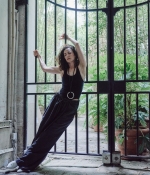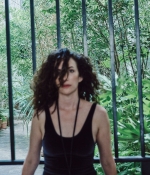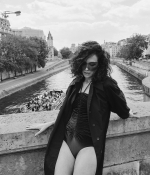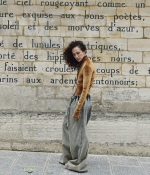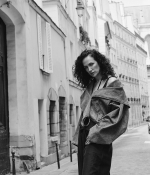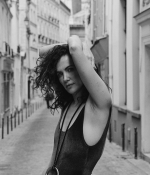Diabolique Magazine – Silent Terror Kate and Mike Discuss Their SXSW Thriller Hush
While the peacefulness of a rural lifestyle carries a lot of appeal, especially for those of us living in busy, noisy urban environments, the idea of living apart from the rest of society carries its own set of anxieties. Hush, the latest film from writer/director Mike Flanagan (Absentia, Oculus), toys with those fears as it imagines a woman living alone who finds her home under attack by a chillingly methodical killer. The sense of vulnerability and isolation is multiplied by the fact that Maddie, a novelist played by co-writer Kate Siegel, is deaf, and without the use of one of her main senses she must be incredibly resourceful in order to survive.
Available on Netflix April 8, Hush is one of the most chilling home invasion thrillers in recent memory, and its success lies in its ability to create an intense and fully realized scenarios that are too plausible to brush out of your mind. Instead of the typical super-human slasher, like the perpetually un-killable Michael Myers, the masked killer in Hush feels like he could be your neighbor. The film had its premiere at SXSW 2016 as part of the festival’s Midnighters program, and we spoke to Mike Flanagan and Kate Siegel about their atypical writing process, and how they collaborated as a team both on and off set.
DIABOLIQUE: I think that’s really interesting because it’s a home invasion movie that people are going to be watching in their living rooms. Do you think that’s going to add anything to the viewing experience?
KATE SIEGEL: I hope so! I hope it makes people afraid to go to bed that night.
MF: [laughs] I just hope they turn up the volume.
DIABOLIQUE: I saw you guys were both writers on the movie. What led you to being writing partners?
KS: Well the idea for the movie happened over dinner one night. Mike and I were discussing thrillers, old movies we liked, and Wait Until Dark came up, which is a favorite of mine and Mike loved it as well. That led us to ideas we’ve had of kind of out-there movies. Mike was talking about how he’s always wanted to experiment with removing sound from a movie, to do a dialogue-less movie. I was talking about a recurring fear I’ve had, which is walking by a window in my house at night and seeing a face outside. And so those two seeds germinated during the course of our meal, and by the time desert was served we had our outline for Hush. We wanted something that was on its face a very basic home invasion movie, but once you step in it turns it on its side.
DIABOLIQUE: It definitely has to play by a different set of rules when you have a protagonist who can’t hear. Did that present a challenge in the writing process to write around that?
KS: I think that was a benefit in the writing process. It became such a fun thing to play with because things you couldn’t do in another movie where the protagonist has all five of their senses, you could really play with. Like what’s going on behind her, she can’t experience. If she can’t see it in front of her and she can’t feel the vibrations, she’s not going to be able to be aware of it. So we got a whole new world opened up to us because oftentimes in genre movies, the sound design is what creates the most fear, the stuff you can’t see, the stuff you can’t hear. Maddie’s deafness and her muteness opened up another level for us.
DIABOLIQUE: Was it hard for you to act without using your voice?
KS: It was! It was probably the biggest challenge I’ve ever taken on. I think when writing it I didn’t know what I was signing up for. Then when I showed up on set and started preparation for a couple weeks I realized that you take away from an actor the two tools they used the most, which is listening and speaking, and you take those away you have to really rely on instinct and breathing and feeling, literal feeling. I would find myself often lying my hands on coffee tables or countertops or windows so I could at least experience the act of listening even if I couldn’t be listening.
DIABOLIQUE: Your sign language looked really natural to me. Was that difficult to learn?
KS: I worked with an incredible coach for months, and she drilled me like a drill sergeant. She was not about to let me get away with having sloppy sign language. One of the other things she did for me which I am very much in debt to her for was talking about the culture, the experiences you have when you’re deaf that people who can hear maybe wouldn’t think of off the top of their head. The frustration, the fact that when you sign the hand gestures are only the first level of communication. There’s a whole bunch of stuff that’s included with that, like your facial expressions, your breath, where you’re looking, how you’re expressing the emotions through your body. So she was invaluable to me in that process. Learning it really helped me get in touch with how Maddie communicates throughout the movie even when she’s not using sign language. Somebody who is using their hands and body to communicate is going to have a much freer level of communication in their face, just in general. It allowed Maddie to be a more open character to the camera, whereas someone who had the same level of emotional isolation and also is a speaking person would probably have been more closed off to the camera.
DIABOLIQUE: With you writing and directing with a clear picture in your head from the beginning, what was your collaboration process like during the writing process and on set?
MF: Well the writing was fun and unusual because we lived together in a house in Glendale, and so our first passes our writing once we knew the kind of movie we wanted to make was that Kate would sit inside and I would go outside and I would try to break into our house, and really walk around the property and look for the realistic ways to get inside. As we would come up with new scenarios, Kate would move around inside the house and see what tools were at her fingertips, and what she would realistically do to combat that. So the first draft of the script was written for our house, and it was fun because we got to role play those scenarios. If we got to a scenario that I thought was realistic for me as the intruder and she thought was realistic as the survivalist, then that was a scenario we would go over and sit down and type out.
KS: And then on set that writing process brought a certain amount of trust to our relationship which translated to on set. Mike ended up having a ton of trust already built in with Trevor Macy on the ground and the crew that he used, which he’s been using for his past three films. What we had in Alabama was one location, night shoots, six day weeks, but a small group of people who really trusted each other. I think that allowed us to explore.
DIABOLIQUE: That’s very cool, so you guys acted it out while you were writing.
MF: Yeah, which is not something you usually get to do. [laughs]
KS: There was no dialogue, so we just had to figure out how it happened. What would you do in that actual situation? What would happen was we would get to a dead end where either Mike was about to get in the house, or I was out of options. We would stop and open the door and sit down and be like “so what would you actually do in that moment?” I think some of our favorite moments in the movie come from those discussions. In real life if someone’s trying to break into your house and it looks like they’re about to win, you don’t get to go “time out honey, come inside!” You need to figure out what you’re going to do next.
DIABOLIQUE: Did any of those scenarios make it into the movie in those moments where we see her imagining things going wrong in what she calls her “writer brain”?
MF: Oh yeah.
KS: Those were all throwaways from earlier drafts.
MF: That scene very realistically represents I think what a writer goes through when you’re trying on different scenarios. Your job is twofold; one is to come up with a scenario and then your next job is immediately to destroy it and poke any holes in it that you can find. It’s a frustrating line to walk when you’re working on a movie. It’s fun to take that frustration of “what if we did this?” and then shoot holes in it and say “no, it won’t work because of this,” and to put that into the movie was really cool. We were nervous initially that that sequence wouldn’t make the cut, but people seem to like it, it’s proven to be really popular.
April 14, 2016
Source
by Wil Barlow

